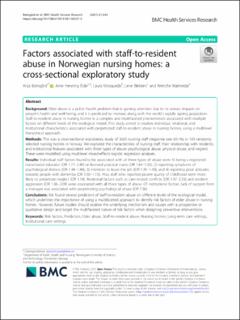| dc.contributor.author | Botngård, Anja | |
| dc.contributor.author | Eide, Arne Henning | |
| dc.contributor.author | Mosqueda, Laura | |
| dc.contributor.author | Blekken, Lene Elisabeth | |
| dc.contributor.author | Malmedal, Wenche Karin | |
| dc.date.accessioned | 2021-03-22T11:25:21Z | |
| dc.date.available | 2021-03-22T11:25:21Z | |
| dc.date.created | 2021-03-20T10:45:47Z | |
| dc.date.issued | 2021 | |
| dc.identifier.citation | BMC Health Services Research. 2021, 21, . | en_US |
| dc.identifier.issn | 1472-6963 | |
| dc.identifier.uri | https://hdl.handle.net/11250/2734796 | |
| dc.description.abstract | Background
Elder abuse is a public health problem that is gaining attention due to its serious impacts on people’s health and well-being, and it is predicted to increase along with the world’s rapidly ageing population. Staff-to-resident abuse in nursing homes is a complex and multifaceted phenomenon associated with multiple factors on different levels of the ecological model. This study aimed to explore individual, relational, and institutional characteristics associated with perpetrated staff-to-resident abuse in nursing homes, using a multilevel hierarchical approach.
Methods
This was a cross-sectional exploratory study of 3693 nursing staff (response rate 60.1%) in 100 randomly selected nursing homes in Norway. We explored the characteristics of nursing staff, their relationship with residents, and institutional features associated with three types of abuse: psychological abuse, physical abuse, and neglect. These were modelled using multilevel mixed-effects logistic regression analyses.
Results
Individual staff factors found to be associated with all three types of abuse were 1) being a registered nurse/social educator (OR 1.77–2.49) or licensed practical nurse (OR 1.64–1.92), 2) reporting symptoms of psychological distress (OR 1.44–1.46), 3) intention to leave the job (OR 1.35–1.40), and 4) reporting poor attitudes towards people with dementia (OR 1.02–1.15). Also, staff who reported poorer quality of childhood were more likely to perpetrate neglect (OR 1.14). Relational factors such as care-related conflicts (OR 1.97–2.33) and resident aggression (OR 1.36–2.09) were associated with all three types of abuse. Of institutional factors, lack of support from a manager was associated with perpetrating psychological abuse (OR 1.56).
Conclusions
We found several predictors of staff-to-resident abuse on different levels of the ecological model, which underlines the importance of using a multifaceted approach to identify risk factors of elder abuse in nursing homes. However, future studies should explore the underlying mechanism and causes with a prospective or qualitative design and target the multifaceted nature of risk factors when designing preventive interventions. | en_US |
| dc.language.iso | eng | en_US |
| dc.publisher | BioMed Central | en_US |
| dc.rights | Navngivelse 4.0 Internasjonal | * |
| dc.rights.uri | http://creativecommons.org/licenses/by/4.0/deed.no | * |
| dc.title | Factors associated with staff-to-resident abuse in Norwegian nursing homes: a cross-sectional exploratory study | en_US |
| dc.type | Peer reviewed | en_US |
| dc.type | Journal article | en_US |
| dc.description.version | publishedVersion | en_US |
| dc.source.volume | 21 | en_US |
| dc.source.journal | BMC Health Services Research | en_US |
| dc.identifier.doi | 10.1186/s12913-021-06227-4 | |
| dc.identifier.cristin | 1899597 | |
| dc.description.localcode | This article is licensed under a Creative Commons Attribution 4.0 International License, which permits use, sharing, adaptation, distribution and reproduction in any medium or format, as long as you give appropriate credit to the original author(s) and the source, provide a link to the Creative Commons licence, and indicate if changes were made. The images or other third party material in this article are included in the article's Creative Commons licence, unless indicated otherwise in a credit line to the material. If material is not included in the article's Creative Commons licence and your intended use is not permitted by statutory regulation or exceeds the permitted use, you will need to obtain permission directly from the copyright holder. To view a copy of this licence, visit http://creativecommons.org/licenses/by/4.0/. The Creative Commons Public Domain Dedication waiver (http://creativecommons.org/publicdomain/zero/1.0/) applies to the data made available in this article, unless otherwise stated in a credit line to the data. | en_US |
| dc.source.articlenumber | 244 | en_US |
| cristin.ispublished | true | |
| cristin.fulltext | original | |
| cristin.qualitycode | 2 | |

